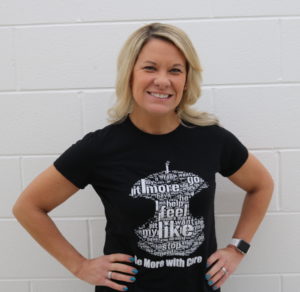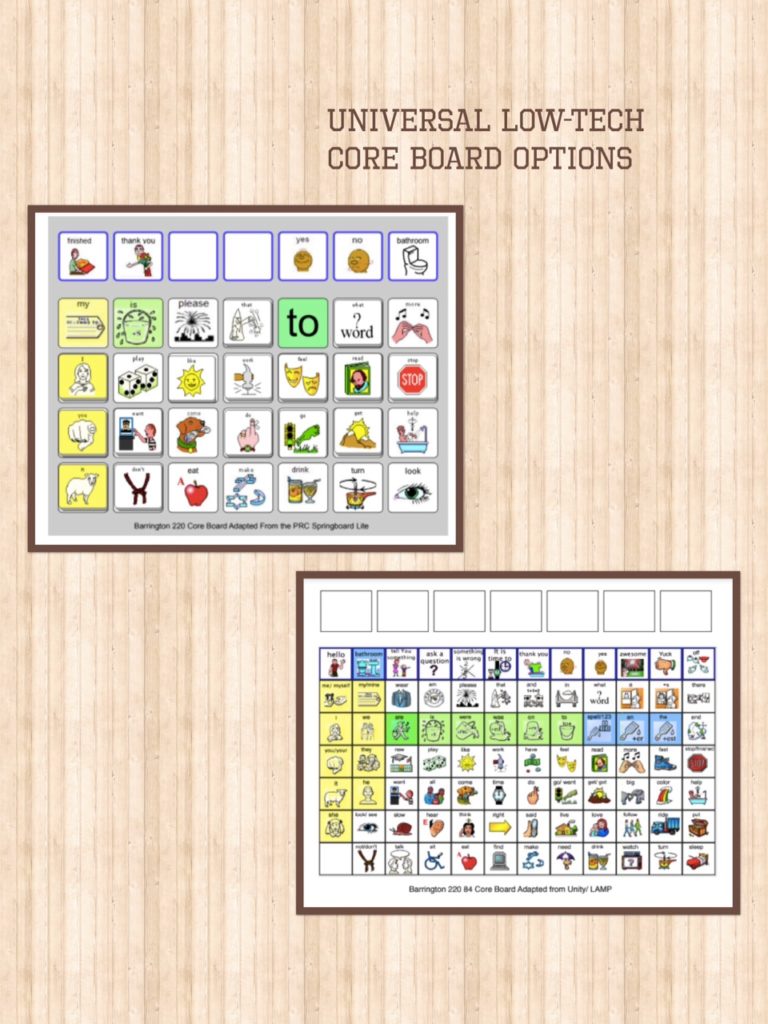9 May 2018 — SpeakUp Editor
Today we are excited to share a post by Kelly Key of District 220 in Barrinton, Illinois. In this first of a two-part post focused on using core vocabulary in the classroom, she shares helpful information about how she successfully incorporated core vocabulary in her school district. Look for Part Two next month where she will be sharing the top 5 tips and activities she uses to increase student’s language and speech-generating device use.
—-
The Importance of Using Core Vocabulary
As most of us know, individuals with complex communication needs must have access to core vocabulary words. Core words are the most commonly used words in the English language and are the most frequently used words in both in reading, writing, and conversation. They can be used in any situation regardless of the age or ability level of the communicator. These words are powerful. They allow us to express a wide variety of concepts with a relatively small number of words. In order to maximize our students’ exposure to core vocabulary (both verbally and visually), I launched our district-wide core vocabulary initiative over 8 years ago.
Overview of Barrington 220’s Universal Core Approach to Language and Literacy
I have worked for Barrington School District in Barrington, Illinois for almost 20 years. Barrington is a unit school district with almost 10,000 students. Our district serves students from ages 3-21. I am our district’s Assistive Technology Coordinator. Eight years ago, I started a core vocabulary initiative. Our teams now call it our Universal Core Approach to Language and Literacy. The original intention for implementing the initiative was to increase the confidence and comfort level of staff and parents in supporting students that use communication devices, after just six months of implementing the initiative, however, our staff realized the approach was more powerful than we expected! It not only helps support our AAC users, but also, many other students who struggle with language and literacy. In our district, we adhere to the following key components that underlie its success:
- Use core vocabulary words based on research (e.g., PRC’s 100 Frequently Used Core Words; Vantatenhove’s Hybrid list based on Banajee’s research; University of North Carolina Chapel Hill’s DLM’s First 40).
- Use universal low- tech core board options (insert images). We use a 28-location board based on PRC’s Springboard 32 and the 84 board adapted from the LAMP Words for Life main page.

- Think in core when developing lessons and activities. Our motto is “When in doubt core it out!” The phrase “core it out” means adapting lessons and activities to include target core words and phrases. Core words and visuals are built into lessons and activities for use in school and in our student’s homes. We also think in core when engineering our visual supports (see image).
- Expose students immediately to core vocabulary when they enter our district at age 3 or move into the district. I like to say it’s like the Oprah’s favorite things episode, “You get a core board and you get a core board!”
- Model AAC (i.e., use partner augmented input), on the boards and devices as much as we can. We say we talk to the students visually and verbally
- Adapt the curriculum. Our Powerful Words core curriculum is in place for our Early Childhood students. This includes visuals, interactive books, video modeling, journaling, songs and more. We are working on the curriculums for our elementary, middle, and high school students and plan to have these complete by the Fall, 2018.
- Meet and discuss. The Core Vocabulary Committee is a group of staff from across the district that meet in person and virtually throughout the year. Our meetings always start with each person bringing a lesson or activity they have “cored out” to share. We then share the file via our Core Google site. During the meetings, we also brainstorm new ideas to help implement core. We also develop and provide professional development for staff, students and parents.
- Share resources. I created a shared Google site where staff can add materials they have created or adapted that are “cored out.” This site also includes our interactive core boards, or core images, our low tech boards, cored out visual supports, and more to download and use with students.
- Train staff, students, parents, and siblings. I provide training in the classrooms and through lessons I provide to the class. I also provide trainings for parents during theday and in the evening to include our yearly “AAC Family Fun Night”. This event has been a huge success each year. The families come with their child that uses AAC. We start the evening with tips for implementation at home and then have stations for families to go to practice using the devices and get comfortable with the language. The families then get to take the materials and games home to use. I also provide training to all new staff during new educator orientation each Fall. I also have had principals get rotating subs to cover school day trainings. Summer trainings and after school trainings have also been a huge success. I have been very fortunate that many of our principals have allowed me to run a series of professional development during their staff meetings as well (to special education and general education staff)!
- Utilize the SETT Process to select an appropriate communication system when our students need something more high tech or more individualized. Our teams hold a SETT meeting (We follow Joy Zabala’s SETT process where the group talks about the Student’s(likes, motivators, access/ motor needs, vision, behaviors, etc), Environment (since communication impacts all environments, the team discusses what supports have been used in the past and current supports and pros and cons of each), Tasks (the group shares what they want the student to be able to communicate that they are not able to communicate. The teams also brainstorms specific vocabulary and phrases and intentions), Tools (for tools, the teams feature match. They talk about what features they would like to see on an AAC system for the student). This is a meeting with the team and parents, and at times the student as well. This is a terrific opportunity to brainstorm ideas as a group and make the decision of which tool to try first. This helps tremendously with device buy in.
We measured outcome data on the program based off of IEP goal achievement as well as pre/post video samples of individual students. Since the implementation of our core initiative our outcomes have included:
- Staff, students and parents comfort level and confidence with using core words and devices increase.
- Increased Related services staff and classified staff empowerment and comfort level with AAC.
- Embedding Core vocabulary words and visuals into the curriculum and daily routine.
- Staff and parent modeling on the boards and devices throughout the day.
- Shifted focus has away from the board or device to more on language and literacy.
- Excitement for sharing resources.
- Most importantly, students are communicating!
Tips for Rolling out Your own Initiative:
- Make it a school, program or district-wide initiative (once you call it an initiative, it’s just what you do!).
- Get your administration knowledgeable and on board with the initiative.
- Determine your anchor symbol set when using a visual to represent a core word.
- Create (or adopt) a low tech board(s).
- Teach staff the value of modeling on the boards and devices.
- Embed core words and visuals in your curriculum materials and visual supports.
- Talk in core. Be conscious of the words you are saying and how you are asking questions to provide core words (i.e., use Gail Vantatenhove’s descriptive teaching method).
- Provide resources for staff and parents to easily access cored out visuals and resources.
- Training! Training! Training! Provide as much training as you can on partner skills. Include staff, students, siblings and parents.
- Hold a SETT meeting for individualized/ customized supports.
Stay tuned for Part Two next month!
References & Resources:
Banajee, M., DiCarlo, C.,& Stricklin, S. (2003). Core vocabulary determination for toddlers. Augmentative and Alternative Communication, 19, 67-73.
DLM Core Vocabulary from Project Core http://www.project-core.com/
LAMP words for LIFE https://aacapps.com/lamp/
Gail Van Tatenhove’s website: www.vantatenhove.com
Minspeak- http://minspeak.com
PRC 100 Frequency core words https://aaclanguagelab.com/files/100highfrequencycorewords2.pdf
Joy Zabala SETT Framework http://www.joyzabala.com/
—–
 Kelly Key is the Assistive Technology Coordinator for the Barrington School District (EC-Transition) in Barrington, Illinois. She has been in her current role for over 14 years. She has also served as an administrator for 13 years as a Special Services Facilitator and Assistant Principal. Prior to becoming an administrator, she taught special education students with multiple needs for 9 years. She has a Bachelor’s degree in Special Education from Northern Illinois University, a Master’s Degree in Early Childhood Special Education from Northern Illinois University, and a Certificate of Advanced Study in Educational Leadership from National Louis University. She also has an ATACP (Assistive Technology Applications Certificate) from the University of California- Northridge.
Kelly Key is the Assistive Technology Coordinator for the Barrington School District (EC-Transition) in Barrington, Illinois. She has been in her current role for over 14 years. She has also served as an administrator for 13 years as a Special Services Facilitator and Assistant Principal. Prior to becoming an administrator, she taught special education students with multiple needs for 9 years. She has a Bachelor’s degree in Special Education from Northern Illinois University, a Master’s Degree in Early Childhood Special Education from Northern Illinois University, and a Certificate of Advanced Study in Educational Leadership from National Louis University. She also has an ATACP (Assistive Technology Applications Certificate) from the University of California- Northridge.
—–
Jill E Senner, PhD, CCC-SLP
Editor-in-Chief

